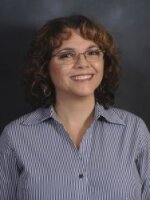Dr. Kristina Killgrove, a researcher from the University of West Florida, is preparing for the trip of a lifetime. She’s heading to Italy soon to study skeletal remains of victims of the 79 A.D. Mount Vesuvius volcano eruption.
Killgrove is a biological anthropologist and assistant professor in UWF’s Anthropology Department. Her classes include Intro to Anthropology, Bioarchaeology, and Human Osteology.
“Some of the things we’re looking at are our teaching tools,” said Dr. Killgrove during a brief tour of the Sciences Lab in Building 13. “We have a full plastic skeleton, he gets a different name every semester. One semester it was “Skeletor” and I liked that very much.”
Killgrove’s fascination with bones and the human body began when she was very young, after she broke her arm at age seven.
“I went to the doctor and the doctor did an X-ray, showed me the X-ray and said ‘do you want me to tell you how tall you’re going to be when you grow up,” she explained. “And I said ‘you can tell that from my bones? That’s amazing.’”
Growing up in Charlottesville near the University of Virginia, which she later attended, Killgrove read old used textbooks about the ancient Greeks and Romans; seeing images of skeletons surrounded by the many artifacts found in the graves.
“And, yet the books only talked about the artifacts,” said Killgrove. “They never talked about the skeletons and what you could learn from the skeletons, but I knew that you could learn stuff from them. So, I always wanted to study them and that was my goal in going to college was to study the ancient Roman skeletons.”
After a colleague from the University of Michigan contacted her about joining the study research project in Italy, she applied for and received a prestigious summer stipend of $6,000 from the National Endowment for the Humanities. (She also received funding from UWF’s Center for Research and Economic Opportunity.)
Specifically, Killgrove will be studying 54 skeletons from Oplontis near the wealthy seaside city of Pompeii, which was destroyed by the eruption of the volcano at Mt. Vesuvius in 79 AD.
“Oplontis is sort of a villa site outside of Pompeii and was for the absolute richest of the rich people,” said Killgrove, explaining that Oplontis consisted of two buildings. “One is a villa, which may have been the villa of Poppaea (Sabina), the wife of the emperor Nero. The other building was an import/export wine business.”
The skeletons were all in one room, believed to be the sea-facing wine market at Oplontis. Killgrove says that suggests the people there were likely waiting for rescue by sea, which was the only way to escape the destruction of Mt. Vesuvius.
Killgrove says it’s thought that one of the individuals might have been the wine merchant.
“There’s actually a wine seal with his name on it that was found at Oplontis. So, they (the skeletons) might be the remains of the wine merchant, his family, and potentially slaves as well.”
The ancient skeletons at Oplontis were discovered between 1984 and 1991, having been long buried beneath the modern town of Torre Annunziata.
Of the 54 total, thirty-three of them already have been excavated, cleaned-and-consolidated, and stored in boxes.
Their research this summer will focus primarily on the remaining 21 skeletons, which have been partially excavated, but remain in the exact spot where they died nearly 2,000 years ago.
Over the six-week research period, Killgrove and her colleagues will create 3-D models and 3-D photogrammetry, which involves the use of photography to measure and map the site.
While researchers already know that the people at Oplontis perished as a result of the volcano eruption, they’re hoping to determine exact cause of death.
“One idea is that people suffocated from the ash that was falling. Essentially the ash turns into cement in the lungs and you die,” Killgrove said. “The other idea is that the people were essentially “flash fried,” that the heat was so intense that their heart stopped and that they died from that.”
All 54 of the skeletons at Oplontis will be subject to osteological analysis, to determine demographic information such as age at death, whether male or female, and stature. Also, samples of their ribs and teeth will be brought back to the U.S. for biochemical analysis in an effort to determine such things as diet and where they were from.
The goal is to create a small-scale environmental reconstruction of the 17-year period dating back from the 79 A.D. Mt. Vesuvius eruption to the first of two earthquakes in the region.
“The 62 A.D. earthquake destroyed parts of villa “A” at Oplontis and it also destroyed things throughout the area like the aqueducts, which would have brought them things like fresh water,” explained Killgrove. “It disrupted the grain supply, so it would have been harder to get food in, and these kinds of things can affect the body. If you don’t have enough water, enough clean water, you can get disease. If you don’t have enough food then the body can tell me that.”
Dr. Killgrove will take part in the research in Southern Italy from early July to mid-August. She has worked on other ancient Roman sites, but points out that nothing really compares to this assignment.
“This is Pompeii, this is right outside of Pompeii, literally the holy grail of archaeology,” she asserted. “You know, if you talk to someone about archaeology, and they know nothing else about archaeology, they’ve heard of Pompeii. So this is the big leagues. I’m so excited about this; it’s literally been a childhood dream.”
This research project in Oplontis is also a dream for Killgrove’s graduate assistant, who is making the trip with her. “We’re both giddy with excitement,” she said.








